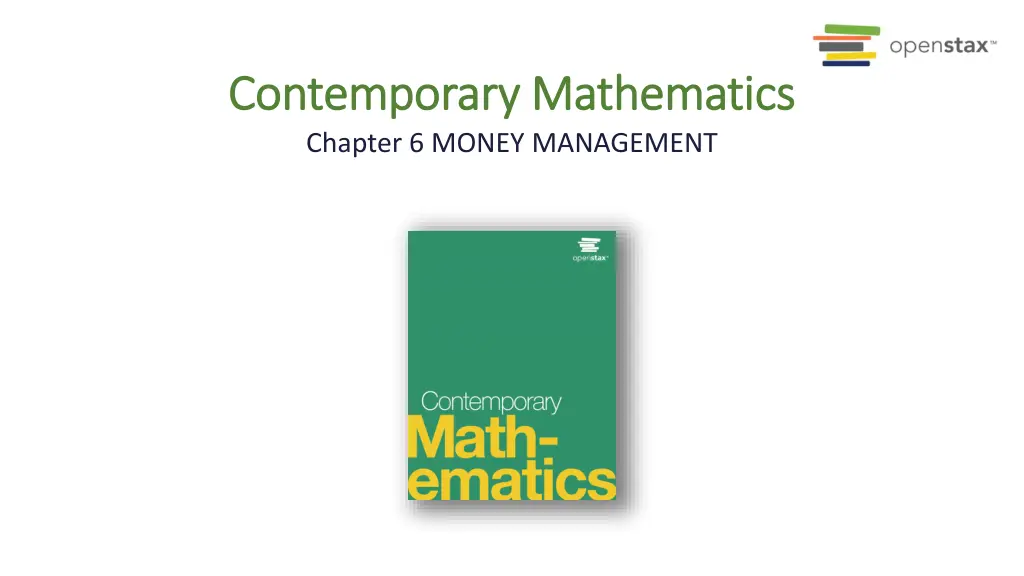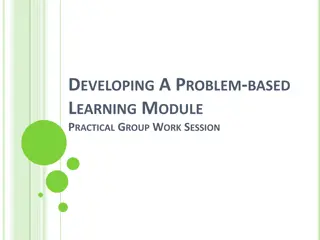
Money Management in Contemporary Mathematics
Explore the concept of compound interest in money management and learn how to compute future and present values. Understand the difference between simple and compound interest calculations and grasp key principles for effective financial planning.
Download Presentation

Please find below an Image/Link to download the presentation.
The content on the website is provided AS IS for your information and personal use only. It may not be sold, licensed, or shared on other websites without obtaining consent from the author. If you encounter any issues during the download, it is possible that the publisher has removed the file from their server.
You are allowed to download the files provided on this website for personal or commercial use, subject to the condition that they are used lawfully. All files are the property of their respective owners.
The content on the website is provided AS IS for your information and personal use only. It may not be sold, licensed, or shared on other websites without obtaining consent from the author.
E N D
Presentation Transcript
Contemporary Mathematics Contemporary Mathematics Chapter 6 MONEY MANAGEMENT
6.4 Compound Interest 6.4 Compound Interest Learning Objectives: 1. Compute compound interest. 2. Determine the difference in interest between simple and compound calculations. 3. Understand and compute future value. 4. Compute present value. 5. Compute and interpret effective annual yield.
6.4 Understand and Compute Compound Interest 6.4 Understand and Compute Compound Interest As we saw in Simple Interest, an account that pays simple interest only pays based on the original principal and the term of the loan. Accounts offering compound interest pay interest at regular intervals. After each interval, the interest is added to the original principal. Later, interest is calculated on the original principal plus the interest that has been added previously. After each period, the interest on the account is computed, then added to the account. Then, after the next period, when interest is computed, it is computed based on the original principal AND the interest that was added in the previous periods.
6.4 Understand and Compute Future Value 6.4 Understand and Compute Future Value The future value of an investment, ?, when the principal ? is invested at an annual interest rate of ? (in decimal form), compounded ? times per year, for ? years, is found using the formula nt r n = + A P . This is 1 also referred to as the future value of the investment.
EXAMPLE EXAMPLE Computing Future Value for Compound Interest Computing Future Value for Compound Interest Compute the future value of the investment with the given conditions. Principal is $5,000, annual interest rate is 3.8%, compounded monthly, for 5 years. ( ) nt 12 5 r n 0.038 12 = + A P = + 1 = 6,044.4332 5,000 1
6.4 Understand and Compute Present Value 6.4 Understand and Compute Present Value The money invested in an account bearing an annual interest rate of ? (in decimal form), compounded ? times per year for ? years, is called the present value, ??, of the account (or of the money) and found using the formula A PV r n = , n t + 1 where ? is the value of the account at the investment s end. Always round this value up to the nearest penny.
EXAMPLE EXAMPLE Computing Present Value Computing Present Value Find the present value of the accounts under the following conditions. ? = $250,000, invested at 6.75 interest, compounded monthly, for 30 years. , + n A = PV n t r 1 = 33,186.2277
6.4 Compute and Interpret Effective Annual Yield 6.4 Compute and Interpret Effective Annual Yield n r n = + Y 1 1 ? = effective annual yield ? = interest rate in decimal form ? = number of times the interest is compounded in a year. ? is interpreted as the equivalent annual simple interest rate.
EXAMPLE EXAMPLE Determine and Interpret Effective Annual Yield Determine and Interpret Effective Annual Yield Suppose you have an investment paying a rate of 6% compounded quarterly. Determine and interpret that effective annual yield of the investment. n r n = + Y 1 1, 4 0.06 4 = + Y 1 1 = 0.0614 = 6.14%
6.5 Making a Personal Budget 6.5 Making a Personal Budget Learning Objectives: 1. Create a personal budget with the categories of expenses and income. 2. Apply general guidelines for a budget.
6.5 Creating a Budget 6.5 Creating a Budget A budget is a plan for how money and resources should be spent. The following are steps that can be used to create your monthly budget. 1. Track your income and expenses. 2. Set your income baseline. 3. Determine your expenses. 4. Categorize your expenses. 5. Total your monthly income and monthly expenses and compare. 6. Save money for unplanned expenses. 7. Use your budget to make decisions and adjust for any changes.
EXAMPLE EXAMPLE Creating a Budget Creating a Budget Compare the total income to total expenses, and determine how much excess income per month she has or how much she falls short by each month. Income Source Amount Expense Amount Nursing $3,765.40 Rent $1,050 Part-time $672.00 Car Payment $489 Student Loan $728 Car Insurance $139 Utilities $130 Clothing $150 Entertainment $300 Credit Card $200 Food $400 Gasoline $250
6.5 The 50 6.5 The 50- -30 30- -20 Budget Philosophy 20 Budget Philosophy Many people pay their bills and then consider all the leftover money to be spending money. However, when developing your own budget, you may want to follow the 50-30-20 budget philosophy, which provides a basic guideline for how your income could be allocated. Fifty percent of your budget is allotted to your needs, 30% of your budget is allotted to pay for your wants, and 20% of your budget is allotted for savings and debt service.
6.6 Methods of Saving 6.6 Methods of Saving Learning Objectives: 1. Distinguish various basic forms of savings plans. 2. Compute return on investment for basic forms of savings plans. 3. Compute payment to reach a financial goal.
6.6 Distinguish Various Basic Forms of Savings Plans 6.6 Distinguish Various Basic Forms of Savings Plans A savings account is a deposit account, held at a bank or other financial institution, which bears some interest on the deposited money. Savings accounts are intended as a place to save money for emergencies or to achieve short-term goals. Experts recommend keeping a savings account balance to cover 3 to 6 months of living expenses in case you should lose your job, have a sudden medical expense, or other emergency. They typically pay a low interest rate, but there is virtually no risk involved, and they are insured by the FDIC for up to $250,000.
EXAMPLE EXAMPLE Single Deposit in a Savings Account Single Deposit in a Savings Account Violet deposits $4,520.00 in a savings account bearing 1.45% interest compounded annually. If she does not add to or withdraw any of that money, how much will be in the account after 3 years? n r n = + A P 1 1 3 0.0145 1 = + $4,520.00 1 = $4,719.48 Violet will have $4,719.48 after 3 years.
6.6 Compute Payment to Reach a Financial Goal 6.6 Compute Payment to Reach a Financial Goal The formula for the amount that needs to be deposited per period, ? ?? ?? ?, of an ordinary annuity to reach a specified goal, ? ?? ?, is n r n FV pmt = , n t r + 1 1 where ? is the annual interest rate (in decimal form), ? ? is the number of periods per year, and ? is the number of years.
EXAMPLE EXAMPLE Saving for a Car Saving for a Car Yaroslava wants to save in order to buy a car, in 3 years, without taking out a loan. She determines that she ll need $35,500 for the purchase. If she deposits money into an ordinary annuity that yields 4.25% interest compounded monthly, how much will she need to deposit each month? = 0.0425 12 n r n 3,5,500 FV pmt = 926.325 pmt = . 12 13 n t 0.0425 12 r + 1 1 + 1 1 To reach her goal, Yaroslava would need to deposit $926.33 in her account each month.
6.7 Investments 6.7 Investments Learning Objectives: 1. Understand basic forms of investments including stocks, bonds, and mutual funds. 2. Compute return on investment for basic forms of investments. 3. Compute future value of investments. 4. Compute payment to reach a financial goal. 5. Identify and distinguish between retirement savings accounts.
6.7 Distinguish Between Basic Forms of Investments 6.7 Distinguish Between Basic Forms of Investments Bonds are issued from big companies and from governments. Bonds are considered a conservative investment. They are bought for what is known as the issue price. The interest is fixed (does not change) at the time of purchase and is based on the issue price of the bond referred to as the coupon rate; the interest paid is often called the coupon yield. The bond is for a fixed length of time. The end of this time is the maturity date of the bond. There are several types of bonds: Treasury bonds are issued by the federal government. Municipal bonds are issued by state and local governments. Corporate bonds are issued by major corporations.
6.7 Stocks 6.7 Stocks Stocks are part ownership in a company. They come in units called shares. The performance and earnings of stocks is not guaranteed, which makes them riskier than any other investment discussed earlier. Their value grows in two ways. They offer dividends, which is a portion of the profit made by the company. And the price per share can increase based on how others see that value of the company changing. If the value of the company drops, or the company folds, the money invested in the stock also drops. The formulas for yield and price to earnings is a good way to measure how much the stock returns per share. The price to earnings ratio of a stock, P/E, is Annual Divdend % Share Price =Share Price. Dividend 100%. The percent yield P/E P/E = for a stock, Yld%, is Yld Yld
EXAMPLE EXAMPLE Buying Stock in Company ABC Buying Stock in Company ABC Haniah buys stock in the ABC company, investing a total of $13,000. She expects the stock to grow, through stock price increase and reinvestment of dividends, by 12.3% per year and compounded annually. If she leaves that money invested, how much will the stocks be worth in 20 years? n 1 20 r n 0.123 1 = + = + = A P 1 $13,000 1 $132,293.49. After 20 years, her stock is now worth $132,293.49.
EXAMPLE EXAMPLE Dividends Paid Dividends Paid Darma owns 150 shares of stock in the GDW company. This quarter, GDW is paying $0.87 per share in dividends. How much will Darma earn in dividends this quarter? Each share pays $0.87, so Darma earns 150 $0.87 = $130.50.
EXAMPLE EXAMPLE Stock Price Increases Stock Price Increases Vincent buys 100 shares in the REM company for $21.87 per share. One year later, he sells those 100 shares for $291.15 per share. How much money did Vincent make? Vincent spent $21.87 per share to buy the stock The total he spent on the stock was $21.87 100 = $2,187.00. When he sold the stock, the price was $29.15 , so he received $29.15 100 = $2,915.00. He made $2,915.00 $2,187.00 = $728.00.
6.7 Mutual Funds 6.7 Mutual Funds A mutual fund is a collection of investments that are all bundled together. When you buys shares of a mutual fund, your money is pooled with the assets of other investors. A key benefit of mutual funds is that they allow small or individual investors to invest in professionally managed portfolios of equities, bonds, and other securities. Since there are many different investments inside the mutual fund, the risk is reduced significantly, compared to direct ownership of stocks. The investments that make up a mutual fund are structured and maintained to match stated investment objectives, which are specified in its prospectus. A prospectus is a pamphlet or brochure that provides information about the mutual fund.
6.7 Retirement Savings Plans 6.7 Retirement Savings Plans Three main forms of retirement savings accounts: traditional individual retirement accounts (IRAs), Roth IRAs, and 401(k). A traditional IRA lets you contribute up to an amount set by the government, which may change from year to year. For example, the maximum contribution for 2022 is $6,000; $7,000 for over age 50. Your money grows tax-deferred, but withdrawals after age 59 are taxed at current rates. Traditional IRAs also allow you to use the contribution itself as a deduction on a current year tax return. Roth IRAs allow contributions at the same levels as traditional IRAs, with a maximum $6,000 for 2022; $7,000 over age 50. However, to be eligible to make contributions, your earned income must be below a certain level. A Roth IRA allows after-tax contributions. Your money grows tax-free. If you make no withdrawals until you are age 59 , there are no penalties. Your employer may offer a retirement account to you. These are often in the form of a 401(k) account. One of the perks some employers offer is to match some amount of your contributions to the 401(k) plan.
EXAMPLE EXAMPLE Matching 401(k) Deposit Matching 401(k) Deposit Alice signs up for her employer-based 401(k). The employer matches any 401(k) contribution up to 6% of the employee salary. Alice s annual salary is $51,600. What is the most money that Alice can deposit that will be fully matched by the company? How much total will deposited into Alice s account if she deposits the full 6%? 0.06 $51,600 = $3,096 $3,096 + $3,096 = $6,192 which is the total that is deposited into Alice s account.






















